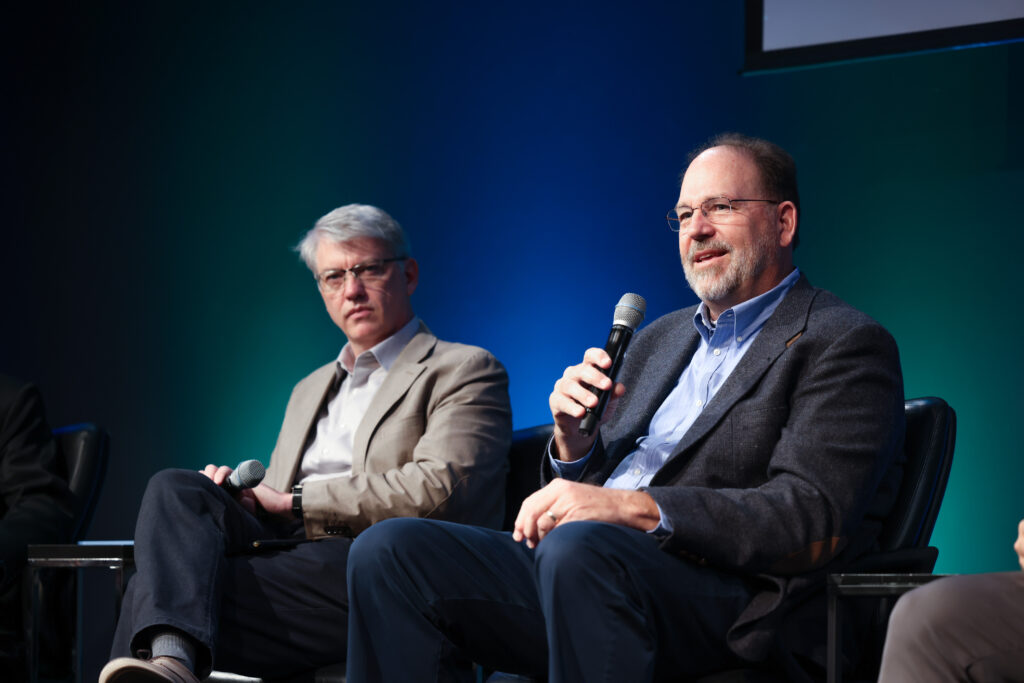By Chris Forrester

Satellite spectrum security is rarely out of the headlines, even on the world’s front pages as well as in trade magazines. Ahsun Murad Co-founder, President/CEO Optimal Satcom reminded delegates that it was a spin-off from Lockheed Martin and Comsat in 2002. Optimal Satcom has since grown to support a large segment of the satellite industry with industry-leading enterprise-level software products and systems for resource management, service planning, optimization, and business intelligence. Over 15 satellite operators, 20 of the largest satellite service providers, and major US Government DoD and civilian agencies use Optimal Satcom products and systems today.
Mr Murad moderated the Satellite Spectrum Security panel at the Silicon Valley Space Week’s MilSat Sysmposium, and with a heavyweight panel of experts on the topic. He explained that security for satellites had totally come to the forefront since the war in the Ukraine. “Jamming was extremely disruptive, and damaging aviation and other aspects of our business, and even as far as GPS over the Baltic countries.” There is a need for resilience, he said, and he asked the panel to review the satellite industry’s vulnerability and approach to overcoming the problem.”
Chris Badgett, VP/Technology, Kratos Space, Training and Cybersecurity. He first told delegates that he wasn’t Eron Musk but promised $1 to those who stayed to the end of the session and requested his pack of information! More seriously, he explained that even with GPS which was now near-ubiquitous but had been suffering jamming for the best part of 20 years and regrettably is a pretty easy service to jam. But GPS is one slice of a signal and beam-forming, using LEO’s, using other operator’s devices meant there are ways to cope and there are mitigations that work, but it is going to require us to understand that there are fixes but in many cases we have to wait for them to come to fruition.
John White, Director/Space Projects, Aitech Defense System said that from the hardware standpoint there are things that can be done perhaps through filtering or blocking signals and our customers are aware of these and it is normal practice. But with these solutions they will still have aspects where the satellite is particularly vulnerable or less effective. A certainty is that there is no ‘one-size fits all’ solution. Worse, a fix can frequently open up other problems.

Matthew Erikson, VP/Solutions, SpiderOak, added that the actual application of Positioning, Navigation and Timing (PNT) is a real headache when even kids today can spoof their Pokémon gameplay to change their apparent location. At SpiderOak we are working with people in the PNT space to understand that when people might send – say – a simple Txt message. Well, how do you know that the sender’s location is a true one? Is the sender lying? We are looking at how to extend the expected assurances from user to user.
Lee Kenyon, Senior Project Leader, The Aerospace Company, said that the fundamental solution for resilience is diversity. There are others, and for PNT in particular there is GPS and the other similar operations, there’s time transfer and ranging over communication links, sensor information, all of which can be fused together to have a better solution, and to help identify spoofed or invalid data. The challenge though is that fielding terminals with this type of sophistication is at a cost, and the DoD has a somewhat chequered history in fielding terminals and in particular dynamic solutions to reflect new innovations and threats. To fulfil these problems in a timely and cost-effective way is a significant challenge.
Mr Murad said that upgrading equipment was tough, given that refreshed systems seemed to be taking a number of years to appear. He asked were software solutions emerging?
Badgett advised that small-form factor terminals were available, and the actual signal processing was lightweight. He suggested that products and solutions from Starlink and Kuiper were helping fill that gap.
John White said that operators were increasingly using multi-faceted, multi-mode solutions.
Erikson added that if physics rears its ugly head and you simply cannot find a solution using software then you can take the rest of the software with elements that are easier to port generation to generation. “Then perhaps the good folk here in Mountain View or Cupertino can come up with solutions that get refreshed every year or two. It is like the smartphones, how many software refreshes have there been which have enabled the core devices to become much more impressive?”
The panel were asked what the biggest threat for the DoD was today, and Badgett said it could be ‘blue on blue’, that was C- and X-band self-interference between commercial and DoD operations. He added that UHF, wonderful as it was also opens up problems with side-lobes and other challenges. Mr White agreed, but added that bandwidth limitations meant that those bands of spectrum were full. “One delegate to the conference had said that every pass of their satellite generated 21 Terabytes of data! The biggest risk is that lack of uplink and downlink speeds.”
